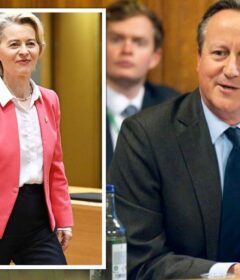Boris Johnson is on course to win the general election according to a new poll
Boris Johnson is likely to win the general election with a majority of 28, according to a highly anticipated new poll.
But the margin of error means that experts cannot rule out a hung parliament.
Labour will take heart that the 28-seat lead is a full 40 seats lower than the same polling predicted two weeks ago suggesting they are managing to squeeze out undecided voters or those considering smaller parties.
YouGov's 'MRP' poll was the first to accurately predict a hung Parliament in the 2017 election.
If the election were held now the Tories could win 339 seats (22 more than they took in 2017) and a vote share of 43%. In terms of seats, this would be the Conservative’s best performance since 1987.
Labour are for the first time predicted to take Cabinet Minister Theresa Villiers’ Chipping Barnet seat which Tories are privately predicting they have lost and which she held by 300-odd votes last time.
The party has also been pouring resources into Justine Greening’s old seat of Putney and that looks set to pay dividends.
But the two Labour gains are dwarfed by 29 Labour seats predicted to go blue – including 49-year veteran Dennis Skinner’s seat of Bolsover.
The party is also predicted to lose Sheffield Hallam, after the diastrous tenure of Jared O'Mara who eventually became an independent, to the Lib Dems.
Two seats of Scotland are likely to fall to the SNP.
A seat-by-seat analysis published by the company on 27 November showed the Tories would win 359 seats, Labour 211, the SNP 43 and the Lib Dems 17 if the election were held then.
That would have given Boris Johnson a far more comfortable 68 seat majority.
Since that polling Labour has pulled back many of these seats – including Tom Watson's former constituency of West Bromwich East.
-
London Bridge attack victim's dad: 'Boris Johnson saw an opportunity in his death'
In November they were set to lose 44 to the Conservatives but this has now dropped to just 29.
The party has put a lot of focus on leave-voting seats in the Midlands and north with Jeremy Corbyn taking time to visit them.
They are back ahead in Weaver Vale, West Bromwich East and Workington – which was identified as a target seat for the Tories at the start of the campaign by a right-wing thinktank.
But despite focussing resources into leave seats and featuring their leave supporting shadow cabinet ministers in TV appearances, of the seats that Labour is defending the recent recovery has been strongest in Remain areas.
Those constituencies which voted Remain have increased vote share by an average 6% while those which voted heavily to Leave have increased by just 2%.
Chingford and Wood Green has been a safe Tory seat since it was created in 1997, and was once held by Iain Duncan Smith.
But with demographic changes and other local factors the comfortable advantage they had has changed. Current results now show a two-point lead for the Conservatives (47% versus Labour’s 45%).
In 2017 Dominic Raab won Esher and Walton with a majority of over 23,000. This constituency also voted Remain at the 2016 EU Referendum. The model shows that tactical voting is producing a shift towards the Lib Dems, with the party now on 44% and closing the gap on the Conservatives (46%).
Chris Curtis, YouGov’s Political Research Manager, said: “Our latest and final poll shows that a small Conservative majority is likely, with the Tories taking 22 more seats than in 2017 and Labour losing 31. This would be the best and worst results respectively for each party since the 80s.
“But the margins are extremely tight and small swings in a small number of seats, perhaps from tactical voting and a continuation of Labour’s recent upward trend, means we can’t currently rule out a hung parliament. As things currently stand there are 85 seats with a margin of error of 5% or less.”
Source: Read Full Article





